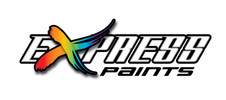Express Paints: Your 2025 SMART Repair Compliance FAQ
24th Oct 2025

Express Paints – SMART Repair Compliance FAQ 2025
Straight answers to what HSE’s campaign really means for SMART repairers.
Q1. Does the HSE’s new inspection campaign include SMART repairers?
Yes — 100%. HSE have confirmed their inspections include anyone spraying isocyanate-containing paints, primers or clears, whether mobile, in a small unit, or in a bodyshop. If you spray 2K products, you fall under the same COSHH 2002 laws as everyone else.
Q2. What’s the difference between “SMART spraying” and “vehicle refinishing”?
HSE’s guide (INDG473 – SMART Paint Spraying) defines SMART work as 'unlikely to exceed 25 ml of paint per coat' and 'not extending to complete panels.' That’s roughly a small scuff or mirror-cap repair. If you’re spraying bumpers, wings, or blends using 150–200 g of paint, you’ve exceeded that threshold. Those jobs are legally vehicle refinishing, meaning you need a spray booth or LEV, air-fed RPE, and health surveillance in place.
Q3. If I’m mobile and don’t have a booth, am I breaking the law?
If you’re spraying 2K isocyanate materials without a booth or approved extraction, and without an air-fed respirator with tested breathing a
ir to BS EN 12021, then yes — you’re breaching COSHH Regulation 7 (failure to adequately control exposure). HSE can issue a Prohibition Notice stopping all spraying immediately.
To stay compliant you can:
1. Switch to non-isocyanate or UV-cured systems, or
2. Use portable extraction and a compliant air supply.
Q4. Are UV-cured clearcoats isocyanate-free?
Yes – most UV clears are 100 % isocyanate-free. They cure with acrylate resins under UV light, not with isocyanate hardeners, removing the respiratory-sensitiser risk.
You still need:
- Nitrile gloves and eye protection (acrylates irritate skin/eyes)
- Good ventilation
- FFP3 or A2/P3 respirator for solvent or aerosol mist
UV clears are ideal for small, fast SMART repairs and are fully COSHH-compliant when used correctly.
Q5. Is INDG473 misleading? It sounds like it allows 2K SMART repairs.
It can be misleading if read literally. INDG473 was written for tiny touch-ups, not modern SMART repair volumes. Once you exceed 25 ml per coat or spray a full panel, HSE class it as refinishing, not SMART spraying — meaning full controls (booth, air-fed RPE, LEV testing, health surveillance) apply.
Q6. Who actually checks paint usage or compliance?
No one measures paint weight — HSE assess exposure risk. They look for visible mist, poor ventilation, lack of RPE or missing COSHH documents. If exposure isn’t controlled, they treat it as a material breach, regardless of how much paint you say you used.
Q7. Will buying a booth make me more likely to be inspected?
No — it does the opposite. HSE target by risk, not equipment. Having a booth, LEV tests and air-fed RPE shows you’re controlling exposure — exactly what they want to see.
Q8. What can HSE do if I’m found non-compliant?
Improvement Notice – Fix by deadline (e.g. missing LEV test)
Prohibition Notice – Immediate stop on spraying
Fee for Intervention (FFI) – £174 /hr for inspection/admin
Prosecution – Continued or serious breach (unlimited fine + potential conviction).
Q9. How can I reduce my risk and stay productive?
• Switch to non-isocyanate or UV systems where possible.
• If using 2K, ensure a booth or portable LEV and air-fed RPE.
• Keep COSHH assessments, LEV & RPE records up to date.
• Carry out annual health surveillance (spirometry + urine test).
• Ask Express Paints for templates, training, and compliant product options.
Q10. What support can Express Paints provide?
We can help with:
• UV-cured & non-isocyanate coating systems
• Breathing-air test kits & RPE guidance
• COSHH templates and signage packs
• Health-surveillance provider referrals
• Staff training through Lechler UK and Arco
Email: billy@expresspaints.co.uk
Website: www.express-paints.co.uk
Disclaimer: This FAQ summarises duties under the COSHH Regulations 2002 and guidance from INDG388, INDG473, and HSG276. Always consult current HSE publications and competent advice before spraying
